#Gavia pacifica
Explore tagged Tumblr posts
Text
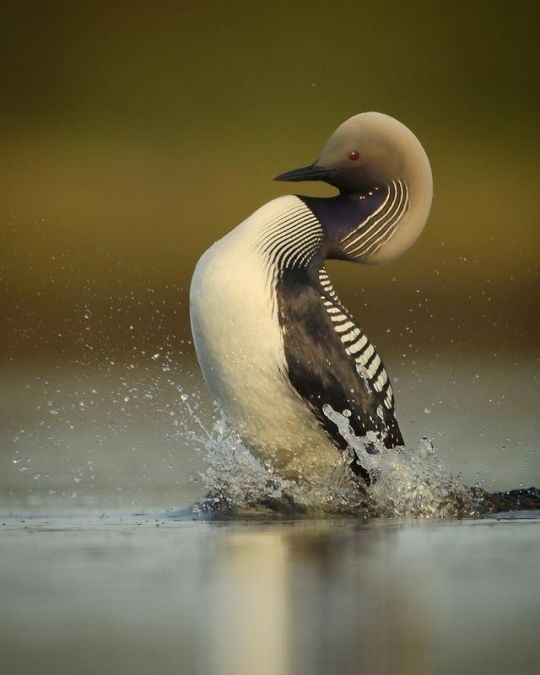
Pacific Loon
88 notes
·
View notes
Text


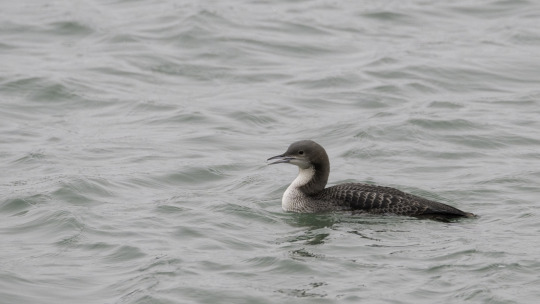
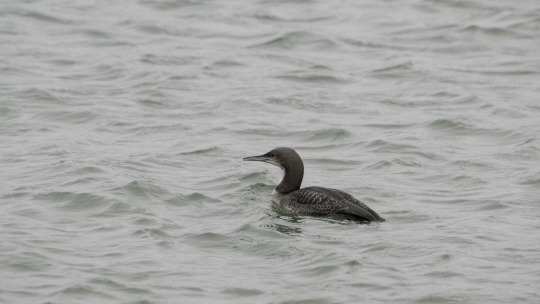


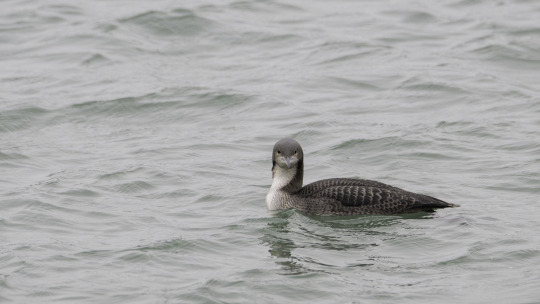
Stillehavslom (Gavia pacifica), 1K
Pacific Loon (Gavia pacifica), 1CY
#Stillehavslom#Gavia pacifica#Pacific Loon#Loon#Lom#Gaviidae#Fugl#Bird#Aves#Juvenile#Ungfugl#Sjælden#Rare#Vinter#Winter#Hanstholm Havn
1 note
·
View note
Text
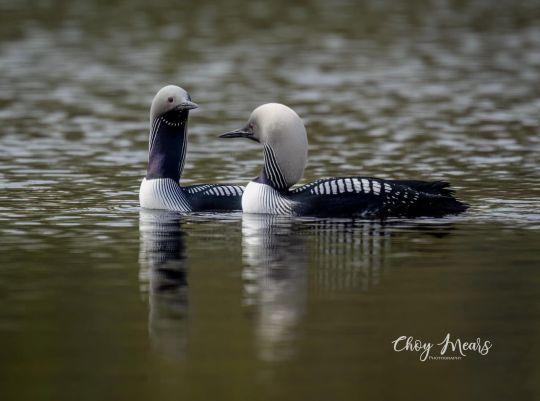
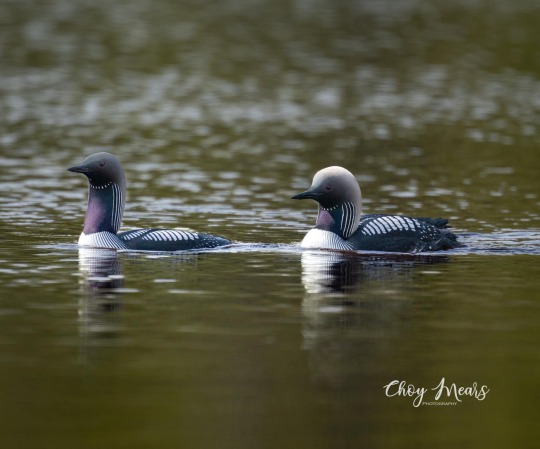
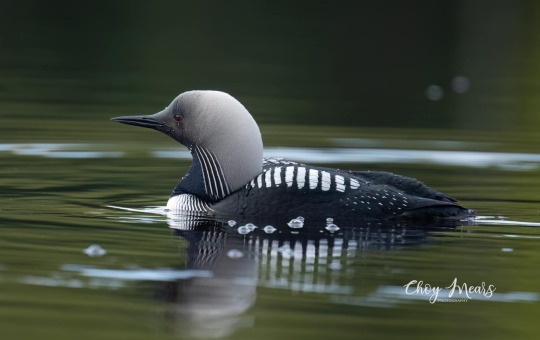
Pacific Loons (Gavia pacifica), family Gaviidae, order Gaviiformes, South-central Alaska, USA
photograph by Choy Mears
1K notes
·
View notes
Text
Pacific loon or Pacific diver (Gavia pacifica)


シロエリオオハム(Pacific Diver)
羽が乾いたらふっくら
593 notes
·
View notes
Text

Pacific Loon (Gavia pacifica)
taken in Newport Beach, California
status: Least Concern
These birds are a bit rarer to see as they only occur along a thin strip of the west coast and during their non-breeding season. This one here is in its non breeding plumage which makes it difficult to identify (and makes it look similar to another loon species that can be seen in the area).
#Pacific Loon#Loon#Gavia pacifica#animal#bird#photo#photography#pacific ocean#canon#canon eos 6D mark ii
1 note
·
View note
Photo

Pacific Loon (Gavia pacifica) >>by Jeff Dyck
448 notes
·
View notes
Photo

Pacific loon (Gavia pacifica)
Live-mount by Charles Anderson
To help support the preservation of our collection click here.
#pacificgrovemuseumofnaturalhistory#museum#collections#pacific grove#monterey#ornithology#taxidermy#pacific loon#gavia pacifica#live-mount
2 notes
·
View notes
Photo

The Moon. Art by Brendan Marnell, from the Pacific Northwest Tarot.
Intuition, illusion, dreams, vagueness, instability, deception, anxiety, fear, misconception, insecurity. Duality.
Pacific loon / Gavia pacifica
The Kickstarter for this deck is currently active.
#Brendan Marnell#Pacific Northwest Tarot#The Moon#Major Arcana#Tarot#Animals#Birds#Loon#Pacific Northwest#Favorites
24 notes
·
View notes
Photo

Pacific Loon (Gavia pacifica), Alaska
photograph by Lisa Hupp/U.S. Fish and Wildlife Service
30 notes
·
View notes
Text
Gavia

Common Loon by Amy Widenhofer, CC BY-SA 2.0
Etymology: Unidentified Sea Bird
First Described By: Coues, 1903
Classification: Dinosauromorpha, Dinosauriformes, Dracohors, Dinosauria, Saurischia, Eusaurischia, Theropoda, Neotheropoda, Averostra, Tetanurae, Orionides, Avetheropoda, Coelurosauria, Tyrannoraptora, Maniraptoromorpha, Maniraptoriformes, Maniraptora, Pennaraptora, Paraves, Eumaniraptora, Averaptora, Avialae, Euavialae, Avebrevicauda, Pygostaylia, Ornithothoraces, Euornithes, Ornithuromorpha, Ornithurae, Neornithes, Neognathae, Neoaves, Aequorlitornithes, Ardeae, Aequornithes, Gaviiformes, Gaviidae
Referred Species: G. egeriana, G. schultzi, G. brodkorbi, G. moldavica, G. paradoxa, G. concinna, G. fortis, G. palaeodytes, G. howardae, G. concinna, G. stellata (Red-Throated Loon), G. arctica (Black-Throated Loon), G. pacifica (Pacific Loon), G. immer (Common Loon), G. adamsii (Yellow-Billed Loon)
Status: Extinct - Extant, Near Threatened - Least Concern
Time and Place: Since 18 million years ago, from the Burdigalian of the Miocene of the Neogene until the Holocene of the Quaternary


Loons have lived throughout the Northern Hemisphere, originating on the Eastern Coast of North America and spreading from there through the Neogene until today
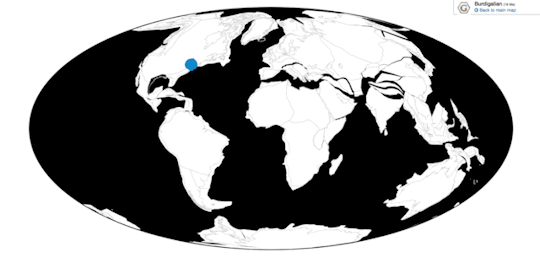
Physical Description: Loons are squat birds, with long bodies and tiny little legs, and very short tails. They also have long necks, with round heads and long pointed beaks. They also have small, beady red eyes. The different species of loon differ greatly on color, though there are some common themes. Their backs are darker, usually black, with white streaks; they often have white bellies that may have some black speckles. They have distinctive black and white striping on the neck - though the extent of the striping varies from species to species, with some Loons having stripes all along the neck, and others only in isolated patches, surrounded by black feathers. The heads are usually a dark color, black or grey, with some lightness more towards the top of the head. They have black feet and flippers attached to their weird lopsided legs. In a lot of ways, Loons are modern, toothless Hesperornithines in general appearance and lopsidedness. They range from 53 to 91 centimeters in length - with many sizes in between.
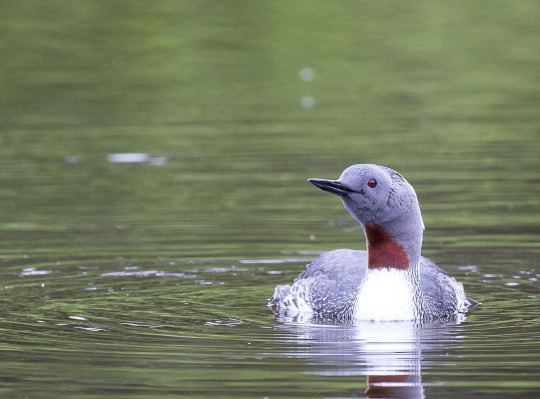
Red-Throated Loon by the Bureau of Land Management, in the Public Domain
Diet: Loons primarily feed on fish, though they will occasionally supplement their diet with other small aquatic animals.

Black-Throated Loon by Bengt Nyman, CC BY 2.0
Behavior: Loons are diving birds, spending most of their time going back and forth in the water searching for food. They will engage in pursuit dives, diving many meters under the water for sources of food, and chasing their fish very vigorously in order to catch them. In some of the better known species, food will be gathered up in ponds and inshore waters and brought back to the young; in the ocean, they’ll join mixed-species flocks in order to gather more fish from the water. Spawns of new fish and crustaceans will often attract groups of Loons to new feeding locations. They tend to swallow gastroliths to aid in crushing hard parts of food in the stomach of the Loons, though they may also aid in causing reguritation when needed Loons are excessively loud during the breeding season and much quieter when hunting; the males will make loud “arroarroarro” and other cackling calls when fighting over territory, which the females often match. The Common Loon especially makes a very distinctive breeding sound, going “ooo-aaaa-eeeeeeeee” and other rising vowel sounds. While nesting, they’ll also make rising, higher-pitched “week-week-week” calls, depending on the species. But, when not breeding, they are fairly silent birds all things considered.

Pacific Loon by Tim Bowman, in the Public Domain
Loons breed mainly in the warmer summertime months, which of course varies extensively based on habitat and location - some loons begin breeding as late as June, while others start as soon as March. It really depends on how quickly the spring begins to thaw to allow for appropriate nesting time. They make nests out of heaps of plant matter placed near the water, laying between one two three eggs into the nest (though usually it’s just two, no more no less). The incubation period lasts for about a month, and the chicks are usually balls of fluffy brownish-grey down. They take around another two months to fledge, depending somewhat on their parents for food during this time. They usually take about two years to reach sexual maturity, and can live for at least a couple of decades (if not longer). Both parents usually take care of the young and will work together to move the nest if needed due to rising water levels.

Common Loon by Mike’s Birds, CC BY-SA 2.0
Loons are fairly strong fliers, though they do have trouble taking off and many have to run along the water surface while flapping wings in order to take flight - only the Red-Throated Loon can take off from land. IN the air, they can fly for long periods of time in order to migrate. Loons have extensive migration ranges, going from warmer coastal waters in the summer to their breeding sites in more northern locations in the winter. They are also extremely strong swimmers. In general, they really aren’t good at walking - the downside of their funkily-placed little legs!

Red-Throated Loon by Don Faulkner, CC BY-SA 2.0
Ecosystem: Loons mainly live in aquatic habitats - in freshwater pools, ponds, and lakes in cold locations such as tundra and taiga habitat; they will also be found on the Arctic and northern Atlantic/Pacific coasts and in rivers and estuaries along those coasts. They especially prefer to stay along the coasts and in sheltered bays during the wintertime, when it is more dangerous to be out on the open waters. They try to stay to deeper freshwater lakes and ponds when in freshwater habitats, rather than more shallow aquatic locations.

Pacific Loon by the NBII, in the Public Domain
Other: Loons are primarily doing fine, conservation wise; only one species is considered Near Threatened, the Yellow-Billed Loon. This species is suffering due to unsustainable fish harvesting, leading to dramatic population declines in recent years. They are also vulnerable to oil-spills and heavy-metal poisoning. These risks also apply to the other Loon species, they just aren’t as heavily hit by them.

Yellow-Billed Loon by Ryan Askren, in the Public Domain
Species Differences: The oldest definite members of Gavia are known from the early-middle Miocene of the Eastern United States. However, loons in general evolved possibly in the Late Cretaceous, at least by the start of the Cenozoic. There are potential members of Gavia as early as the Eocene. This indicates that Loons evolved fairly rapidly in direct response to vacant niches after the mass extinctions of the time. Other fossil species of Loon include G. egeriana from the Early Miocene of the United States and potentially Czechoslovakia; G. schultzi from the Middle Miocene of Austria; G. brodkorbi from the Late Miocene of the United States; G. moldavica from the Late Miocene of Moldova, G. paradoxa from the Late Miocene of the Ukraine, G. concinna from the Late Miocene and Early Pliocene of the United States, G. fortis from the Early Pliocene of the United States, G. palaeodytes from the Early Pliocene of the United States, G. howardae from the Early Pliocene of the United States, and G. concinna from the late Pliocene of San Diego. This showcases how Loons were much more widely distributed for much of their history, found in more southerly locations during the Neogene and up until the Ice Age.
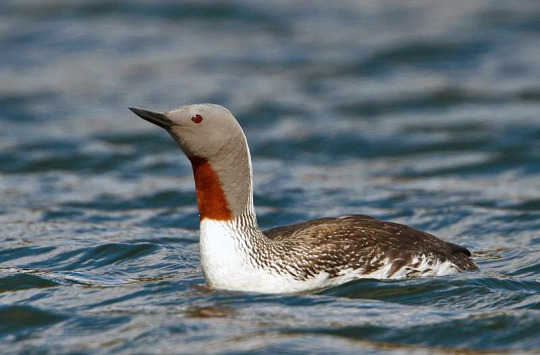
Red-Throated Loon by Ómar Runólfsson, CC BY 2.0
Today, there are five living Loons, with distinctly different appearances and slightly different ranges. Red-Throated Loons spend their summers in the Arctic Ocean area - so along the northern parts of Russia, Canada, and around Greenland, Alaska, and Scandinavia. They will spend their winters along the coasts of both the Atlantic and Pacific oceans. They are some of the smallest loons, and also the most lightly colored - they have brown plumage and red patches on the front of their necks, and their heads and necks are primarily grey.
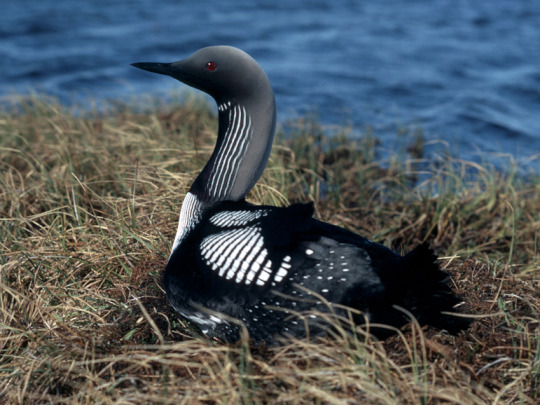
Black-Throated Loon by Robert Bergman, in the Public Domain
Black-Throated Loons have similar ranges to the Red-Throated Loons, but only in Eurasia - they are rarely found in North America, only some parts of Alaska. They are also somewhat smaller, but they are black in color over most of their body with distinctive white patches. The tops of their necks and heads are grey, while they have black patches on their throats and black and white striping across their necks.

Pacific Loon by Alan Vernon, CC BY 2.0
The Pacific Loon is found more in North America than in Eurasia, occasionally reaching Northeastern Russia and wintering in Japan and Korea. They also winter along the pacific coast of North America. They are the smallest of all Loons, and look very similar to Black-Throated Loons except for their size and having nrounded heads and thinner bills.

Common Loon by John Picken, CC BY 2.0
Common Loons live throughout the Northernmost part of North America, even extending somewhat into the Continental US; they also will winter along the coasts of North America. They can be found in Greenland and Western Europe, as well as Scandinavia, during the winter; they also congregate in Iceland during the winter. They are larger loons, and don’t have as much striping on their necks; their backs are also in a funky black and white checkerboard pattern.

Yellow-Billed Loon by Norbert Potensky, CC BY-SA 3.0
Finally, the Yellow-Billed Loon - unlike all other loons - have yellow bilsl, instead of grey ones. They have a similar range to the Red-Throated Loon, though somewhat more limited. They also grow extensively large, and have somewhat larger stripe patches on their necks than Common Loons - though not as much as other Loon species.
~ By Meig Dickson
Sources Under the Cut
Appleby, R.H.; Steve C. Madge; Mullarney, Killian (1986). "Identification of divers in immature and winter plumages". British Birds. 79 (8): 365–91.
Armstrong, Edward A. (1970) [1958]. The Folklore of Birds. New York, NY: Dover Publications.
Arnott, W.G. (1964). "Notes on Gavia and Mergvs in Latin Authors". Classical Quarterly. New Series. 14 (2): 249–62.
Bird, Louis; Brown, Jennifer S.H. (2005). Telling Our Stories: Omushkego Legends and Histories from Hudson Bay. Peterborough, ON, Canada: Broadview Press.
Brodkorb, P. 1953. A review of the Pliocene loons. Condor 55(4):211-214
Brodkorb, P. 1955. The avifauna of the Bone Valley Formation. Florida Geological Survey Report of Investigations 14:1-57
Brodkorb, Pierce (1963). "Catalogue of fossil birds. Part 1 (Archaeopterygiformes through Ardeiformes)". Bulletin of the Florida State Museum, Biological Sciences. 7 (4): 179–293.
Broughton, J. M. 2004. Prehistoric human impacts on California birds: evidence from the Emeryville shellmoumd avifauna. Ornithological Monographs 56:1-90
Carboneras, Carles (1992). "Family Gaviidae (Divers)". In Josep del Hoyo; Andrew Elliott; Jordi Sargatal (eds.). Handbook of the Birds of the World, Volume 1: Ostrich to Ducks. Barcelona, Spain: Lynx Edicions.
Carboneras, C. & Garcia, E.F.J. (2019). Arctic Loon (Gavia arctica). In: del Hoyo, J., Elliott, A., Sargatal, J., Christie, D.A. & de Juana, E. (eds.). Handbook of the Birds of the World Alive. Lynx Edicions, Barcelona.
Carboneras, C., Christie, D.A. & Garcia, E.F.J. (2019). Common Loon (Gavia immer). In: del Hoyo, J., Elliott, A., Sargatal, J., Christie, D.A. & de Juana, E. (eds.). Handbook of the Birds of the World Alive. Lynx Edicions, Barcelona.
Carboneras, C., Christie, D.A. & Garcia, E.F.J. (2019). Red-throated Loon (Gavia stellata). In: del Hoyo, J., Elliott, A., Sargatal, J., Christie, D.A. & de Juana, E. (eds.). Handbook of the Birds of the World Alive. Lynx Edicions, Barcelona.
Carboneras, C., Christie, D.A. & Garcia, E.F.J. (2019). Yellow-billed Loon (Gavia adamsii). In: del Hoyo, J., Elliott, A., Sargatal, J., Christie, D.A. & de Juana, E. (eds.). Handbook of the Birds of the World Alive. Lynx Edicions, Barcelona.
Carroll, R. L. 1988. Vertebrate Paleontology and Evolution 1-698
Cassidy, Frederic Gomes; Hall, Joan Houston (1985). Dictionary of American Regional English: Volume1, A–C. Cambridge, MA: Harvard University Press.
Chandler, R. M. 1990. Fossil birds of the San Diego Formation, Late Pliocene, Blancan, San Diego County, California. Ornithological Monographs 44:73-161
Clements, J. F., T. S. Schulenberg, M. J. Iliff, D. Roberson, T. A. Fredericks, B. L. Sullivan, and C. L. Wood. 2017. The eBird/Clements checklist of birds of the world: v2017
del Hoyo, J., Collar, N. & Garcia, E.F.J. (2019). Pacific Loon (Gavia pacifica). In: del Hoyo, J., Elliott, A., Sargatal, J., Christie, D.A. & de Juana, E. (eds.). Handbook of the Birds of the World Alive. Lynx Edicions, Barcelona.
Evers, David C., James D. Paruk, Judith W. Mcintyre and Jack F. Barr. 2010. Common Loon (Gavia immer), The Birds of North America Online (A. Poole, Ed.). Ithaca: Cornell Lab of Ornithology
Guthrie, D. A. 1992. A late Pleistocene avifauna from San Miguel Island, California. Science Series (Los Angeles) 36:319-327
Hastings, A. K., and A. C. Dooley. 2017. Fossil-collecting from the middle Miocene Carmel Church Quarry marine ecosystem in Caroline County, Virginia. The Geological Society of America Field Guide 47:77-88
Howard, H. 1949. New avian records for the Pliocene of California. Carnegie Instuitution of California 584:179-200
Howard, H. 1972. Type specimens of avian fossils in the collections of the Natural History Museum of Los Angeles County. Contributions in Science 1-27
Howard, H. 1978. Late Miocene marine birds from Orange County, California. Natural History Museum of Los Angeles County Contributions in Science 290:1-26
Howard, H. 1982. Fossil birds from Tertiary marine beds at Oceanside, San Diego County, California, with discriptions of two species of the genera Uria and Cepphus (Aves: Alcidae). Contributions in Science, Natural History Museum of Los Angeles County 341:1-15
Jobling, J. A. 2010. The Helm Dictionary of Scientific Bird Names. Christopher Helm Publishing, A&C Black Publishers Ltd, London.
Lambrecht, K. 1933. Handbuch der Palaeornithologie. 1-1024
Linnaeus, C. 1758. Systema Naturae per Regna Tria Naturae, Secundum Classes, Ordines, Genera, Species, cum Characteribus, Differentiis, Synonymis, Locis. Editio Decima 1:1-824
Mayr, Gerald (2004). "A partial skeleton of a new fossil loon (Aves, Gaviiformes) from the early Oligocene of Germany with preserved stomach content" (PDF). J. Ornithol. 145 (4): 281–86.
Mayr, Gerald (2009). Paleogene Fossil Birds. Heidelberg/New York: Springer-Verlag.
Miller, L., and R. I. Bowman. 1958. Further bird remains from the San Diego Pliocene. Contributions in Science, Los Angeles County Museum 20:1-15
Mlíkovský, Jirí (2002). Cenozoic Birds of the World, Part 1: Europe (PDF). Prague: Ninox Press.
Mobley, Jason A. (2008). Birds of the World. Marshall Cavendish. p. 382.
Montana Fish, Wildlife & Parks (Montana FW&P) (2007): Animal Field Guide: Common Loon; retrieved 2007-05-12.
Moran, Mark; Sceurman, Mark; Godfrey, Linda S. & Hendricks, Richard D. (2005): Weird Wisconsin: Your Travel Guide to Wisconsin's Local Legends and Best Kept Secrets. Sterling Publishing. ISBN 0-7607-5944-8, p. 78
Olson, Storrs L. (1985). "Section X.I. Gaviiformes" (PDF). In Farner, D.S.; King, J.R.; Parkes, Kenneth C. (eds.). Avian Biology. 8. pp. 212–14.
Olson, S. L., and P. C. Rasmussen. 2001. Miocene and Pliocene birds from the Lee Creek Mine, North Carolina. Smithsonian Contributions to Paleobiology 90:233-365
Parmalee, P. W. 1992. A late Pleistocene avifauna from northwestern Alabama. Science Series, Los Angeles Museum of Natural History, Science, and Art 36:307-318
Piper, W.H.; Evers, D.C.; Meyer, M.W.; Tischler, K.B. & Klich, M. (2000): Do common loons mate for life?: scientific investigation of a widespread myth. In: McIntyre, J. & Evers, D.C. (eds.): Loons: old history and new findings – proceedings of a symposium from the 1997 meeting of the American Ornithologists' Union: 43–49. North American Loon Fund, Meredith, New Hampshire.
Piper, W.H.; Tischler, K.B. & Klich, M. (2000). "Territory acquisition in loons: The importance of take-over". Animal Behaviour. 59 (2): 385–94.
Piper, W.H.; Walcott, C.; Mager, J.N.; Perala, M.; Tischler, K.B.; Harrington, Erin; Turcotte, A.J.; Schwabenlander M. & Banfield, N. (2006). "Prospecting in a Solitary Breeder: Chick Production Elicits Territorial Intrusions in Common Loons". Behavioral Ecology. 17 (6): 881–888.
Piper, W.H.; Walcott, C.; Mager, J.N. & Spilker, F. (2008). "Nestsite selection by male loons leads to sex-biased site familiarity". Journal of Animal Ecology. 77 (2): 205–10.
Piper, W.H.; Walcott, C.; Mager, J.N. & Spilker, F. (2008b). "Fatal Battles in Common Loons: A Preliminary Analysis". Animal Behaviour. 75 (3): 1109–15.
Rasmussen, Pamela C. (1998). "Early Miocene Avifauna from the Pollack Farm Site, Delaware" (PDF). Delaware Geological Survey Special Publication. 21: 149–51.
Shufeldt, R. W. 1915. Fossil birds in the Marsh Collection of Yale University. Transactions of the Connecticut Academy of Arts and Sciences 19:1-110
Sjölander, S. & Ågren, G. (1972). "The reproductive behaviour of the Common Loon". Wilson Bull. 84 (3): 296–308.
Sjölander, S. & Ågren, G. (1976). "The reproductive Behavior of the Yellow-billed Loon, Gavia adamsii (with G. Ågren)". The Condor. 78 (4): 454–63.
Slack, K.E.; Jones, C.M.; Ando, T.; Harrison G.L.; Fordyce R.E.; Arnason, U. & Penny, D. (2006). "Early Penguin Fossils, plus Mitochondrial Genomes, Calibrate Avian Evolution". Mol. Biol. Evol. 23 (6): 1144–55.
Stolpe, M. (1935). "Colymbus, Hesperornis, Podiceps:, ein Vergleich ihrer hinteren Extremität". J. Ornithol. (in German). 80 (1): 115–128.
Storer, Robert W. (1956). "The Fossil Loon, Colymboides minutus" (PDF). Condor. 58 (6): 413–426.
Wetmore, Alexander (1941). "An Unknown Loon from the Miocene Fossil Beds of Maryland" (PDF). Auk. 58 (4): 567.
Zelenkov, N. V., E. N. Kurochkin, A. A. Karhu and P. Ballmann. 2008. Birds of the Late Pleistocene and Holocene from the Palaeolithic Djuktai cave site of Yakutia, eastern Siberia. Oryctos 7:217-226
#Gavia#Loon#Bird#Dinosaur#Aequorlitornithian#Ardeaen#Birds#Dinosaurs#Prehistoric Life#Paleontology#Prehistory#Factfile#Birblr#Palaeoblr#Water Wednesday#Neogene#Quaternary#Piscivore#North America#Eurasia#Red-Throated Loon#Black-Throated Loon#Arctic Loon#Pacific Loon#Common Loon#Yellow-Billed Loon#biology#a dinosaur a day#a-dinosaur-a-day#dinosaur of the day
228 notes
·
View notes
Photo



Some lovely Pacific loons [Gavia pacifica] swimming in Monterey County, California. Images by Ron Wolf.
51 notes
·
View notes
Photo
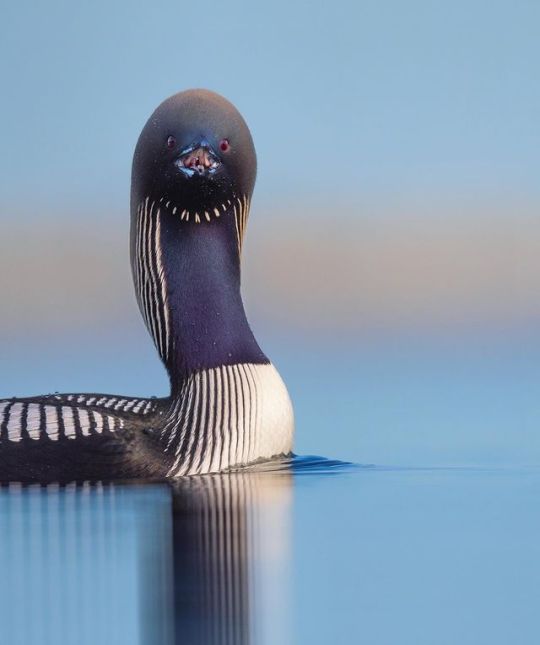
Pacific Loon
108 notes
·
View notes
Text
Bird-a-thon 2017 Recap
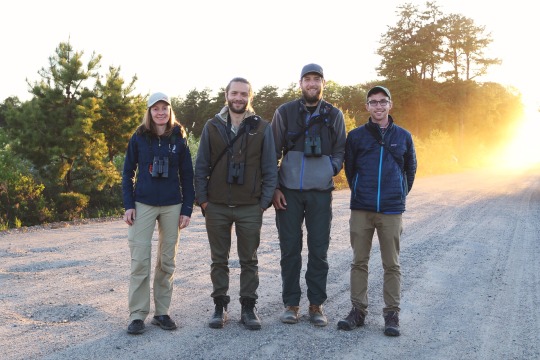
We few, we happy few, we band of birders.
On the 20th, I had the pleasure of spending 22 hours on the road with the Maine Audubon, completing the biggest “big day” of my life so far. Our team was “The Kylo Wrens” because birding+sleep deprivation=Star Wars-themed bird puns. We identified 146 species of birds, beating the other team by 9 species.
My plans of keeping detailed notes throughout the day were thwarted by the simple task of keep our species count list updated, so the minute details of the day are lost to time. Here’s a quick recap of what I can remember though.
Starting off at 12:00am standing less than three feet from a loudly clacking King Rail that despite our best efforts (and Seth’s night vision goggles) we weren’t able to actually spot. We literally witnessed the grass moving as the rail picked it’s way through, yet weren’t able to spot a single feather of the bird itself. Rails are cool.
Dipping on an Eastern Screech Owl and being mystified by some dubious mammal screeching in the distance.
Gas station Woodcock peent in Farmington.
The boreal forest along Boy Scout Rd in Rangely is cold at dawn. It’s also filled with some great warblers too.
Lena is extremely good at mimicking bird calls.
Seth spotted the same Barred Owl twice, two hours apart, but none of us managed to see it either time.
Day’s Store in Belgrade is one of the best general stores in the history of mankind. It’s got everything.
Never being more excited to be looking at a sandpit than when I discovered there could be Bank Swallows nesting in them.
Sleepy raccoon in the trees at Capisic Pond Park in Portland.
Quick detour when Doug thinks he spotted a White-winged Dove. Our schedule prevents us from picking apart every bush in the nearby area.
Literally hundreds of feeding terns and flying scoters along the rocks at Biddeford Pool, all lit up brilliantly by the setting sun.
Dipping on a Mute Swan but coming up with a Pacific Loon instead.
18 hours in and no one’s seen a damn Hairy Woodpecker.
The almost inaudible chirping of Grasshopper Sparrows at Kennebunk Plains.
Ending the day talking birding stories and eating homemade guac while listening to Whip-poor-wills calling all around us.
Finally turning up two hooting Barred Owls and deciding to call it a night.
For those of you who are just really into lists, here’s one of all the Life List species that this novice birder ticked off on the trip (in reverse order):
Eastern Whip-poor-will - Antrostomus vociferus
Upland Sandpiper - Bartramia longicauda
Grasshopper Sparrow - Ammodramus savannarum
Vesper Sparrow - Pooecetes gramineus
Eastern Meadowlark - Sturnella magna
Pacific Loon - Gavia pacifica
Roseate Tern - Sterna dougallii
Red Knot - Calidris canutus
Short-billed Dowitcher - Limnodromus griseus
Willow Flycatcher - Empidonax traillii
Black Tern - Chlidonias niger
Bank Swallow - Riparia riparia
Tennessee Warbler - Oreothlypis peregrina
King Rail - Rallus elegans
It was an eye-opening trip for me and a privilege to spend time with such great birders. Thanks for everything Doug, Lena, and Seth. I have gained an appreciation for how learning habitat is the gateway to more productive birding. Hopefully I can use that down the road.

1 note
·
View note
Note
I don't know if this is a stupid question, but are loons actually incapable of moving on land? I find the concept of it very strange since they'd at least need to be able to create a nest to lay their eggs
Loons (Divers)
Oh no its not a stupid question. I have heard this, as well.
Loons are capable of moving around on the land. They do not move around well on the land, though. Their movement is less like walking and more like scooting and lurching. They are able to push themselves into a short run. They are not terribly capable on the land, because their legs are so far back on the body.
They do mate on land and nest on the land (very close to the water's edge). They gather much of the nesting material from the land near the water.

Common Loon or Great Northern Diver (Gavia immer), family Gaviidae, order Gaviiformes, northern U.S.
photograph by Richard D. Pick

Pacific Loon (Gavia pacifica), family Gaviidae, order Gaviiformes, Utqiaġvik, North Slope, Alaska
photograph by Tyler Ficker

Red-throated Loon or Red-throated Diver (Gavia stellata), family Gaviidae, order Gaviiformes, Iceland
photograph by David Karnå
276 notes
·
View notes
Photo

Pacific Loon, Gavia pacifica. September 6, 2017.
0 notes
Photo

A Very Alien Looking Pacific Loon With Glowing Red Eyes by Gary Lackie Pacific Loon (Gavia pacifica)
418 notes
·
View notes